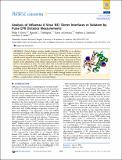Analysis of influenza A virus NS1 dimer interfaces in solution by pulse EPR distance measurements
Abstract
Pulsed electron-electron double resonance (PELDOR) is an electron paramagnetic resonance (EPR) spectroscopy technique for nanometer distance measurements between paramagnetic centres such as radicals. PELDOR has been recognized as a valuable tool to approach structural questions in biological systems. In this manuscript we demonstrate the value of distance measurements for differentiating competing structural models on the dimerization of the effector domain (ED) of the non-structural protein 1 (NS1) of the influenza A virus. Our results show NS1 to be well amenable to nanometer distance measurements by EPR, yielding high quality data. In combination with mutants perturbing protein dimerization and in silico prediction based on crystal structures we can exclude one of two potential dimerization interfaces. Furthermore, our results lead to a viable hypothesis of a NS1 ED:ED interface which is flexible through rotation around the vector interconnecting the two native cysteines. These results prove the high value of pulse EPR as a complementary method for structural biology.
Citation
Kerry , P S , Turkington , H L , Ackermann , K , Jameison , S A & Bode , B E 2014 , ' Analysis of influenza A virus NS1 dimer interfaces in solution by pulse EPR distance measurements ' , Journal of Physical Chemistry B , vol. 118 , no. 37 , pp. 10882-10888 . https://doi.org/10.1021/jp508386r
Publication
Journal of Physical Chemistry B
Status
Peer reviewed
ISSN
1520-6106Type
Journal article
Description
H.L.T. was supported by the University of St Andrews; S.A.J. is supported by the BBSRC, U.K.; P.S.K. is supported by the Medical Research Council, U.K.; B.E.B. is grateful for an EaStCHEM Hirst Academic Fellowship by the School of Chemistry, St Andrews, and funding from the People Programme (Marie Curie Actions) of the European Union’s Seventh Framework Programme [REA 334496]. This work was supported by the Wellcome Trust [099149/Z/12/Z].Collections
Items in the St Andrews Research Repository are protected by copyright, with all rights reserved, unless otherwise indicated.

